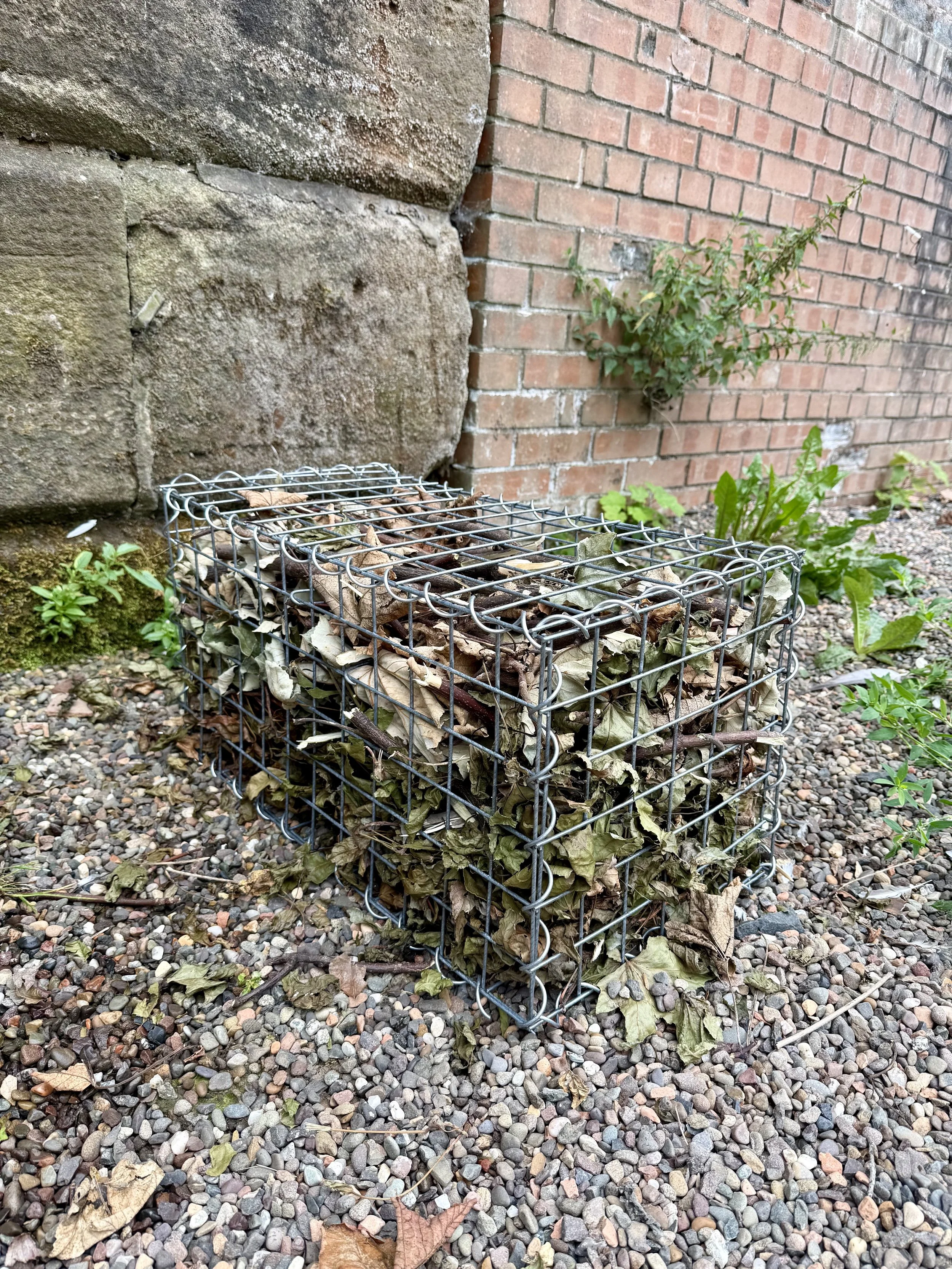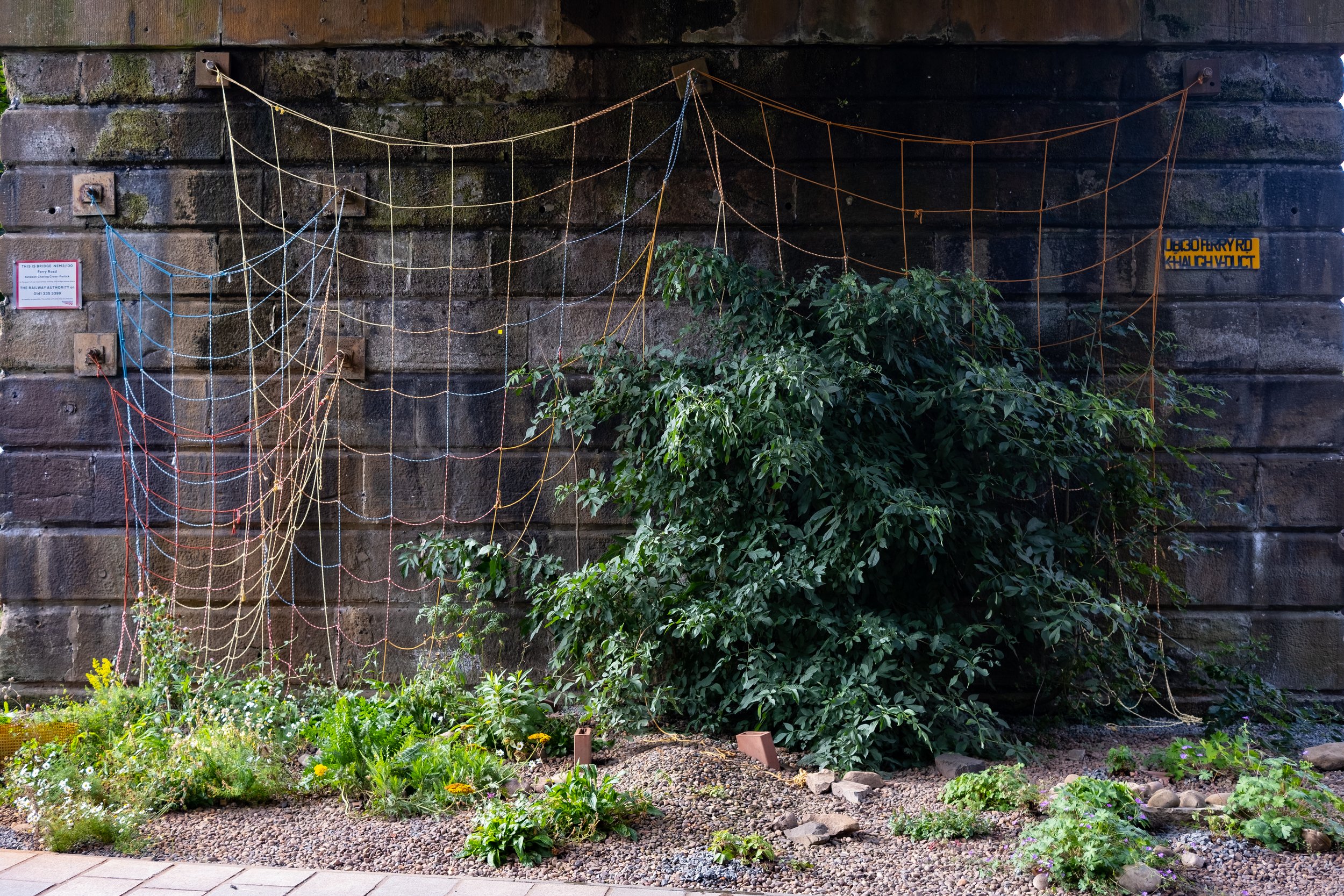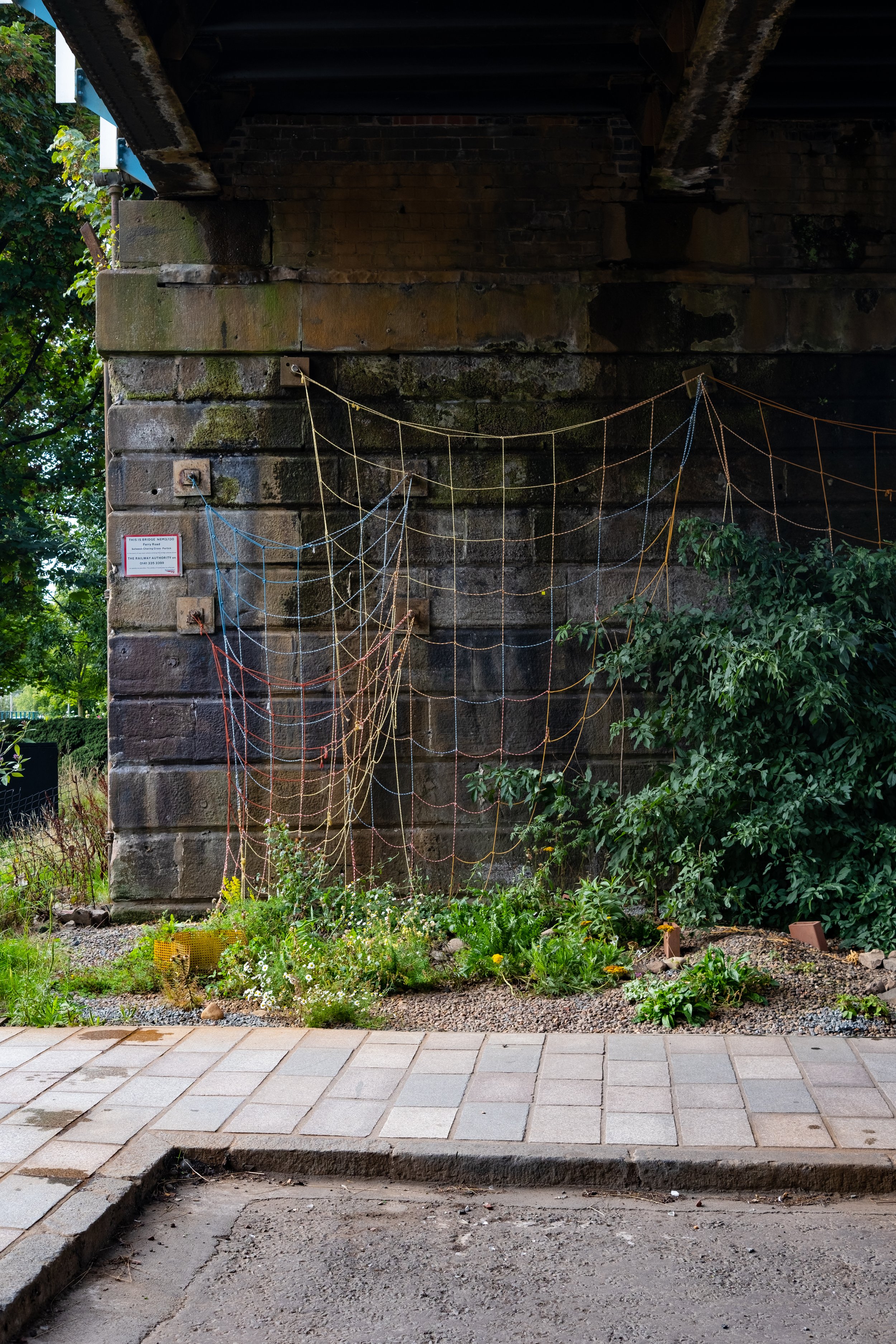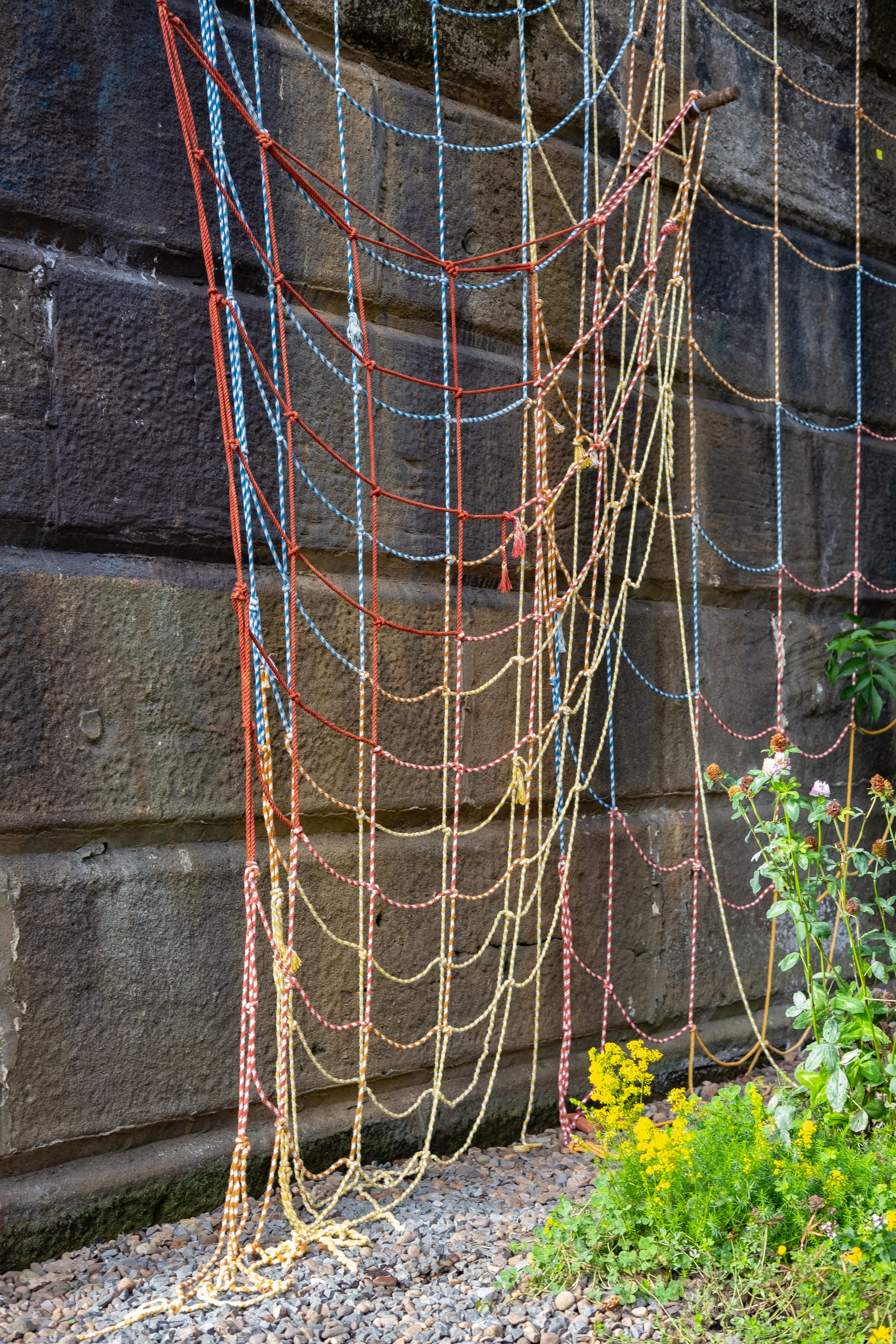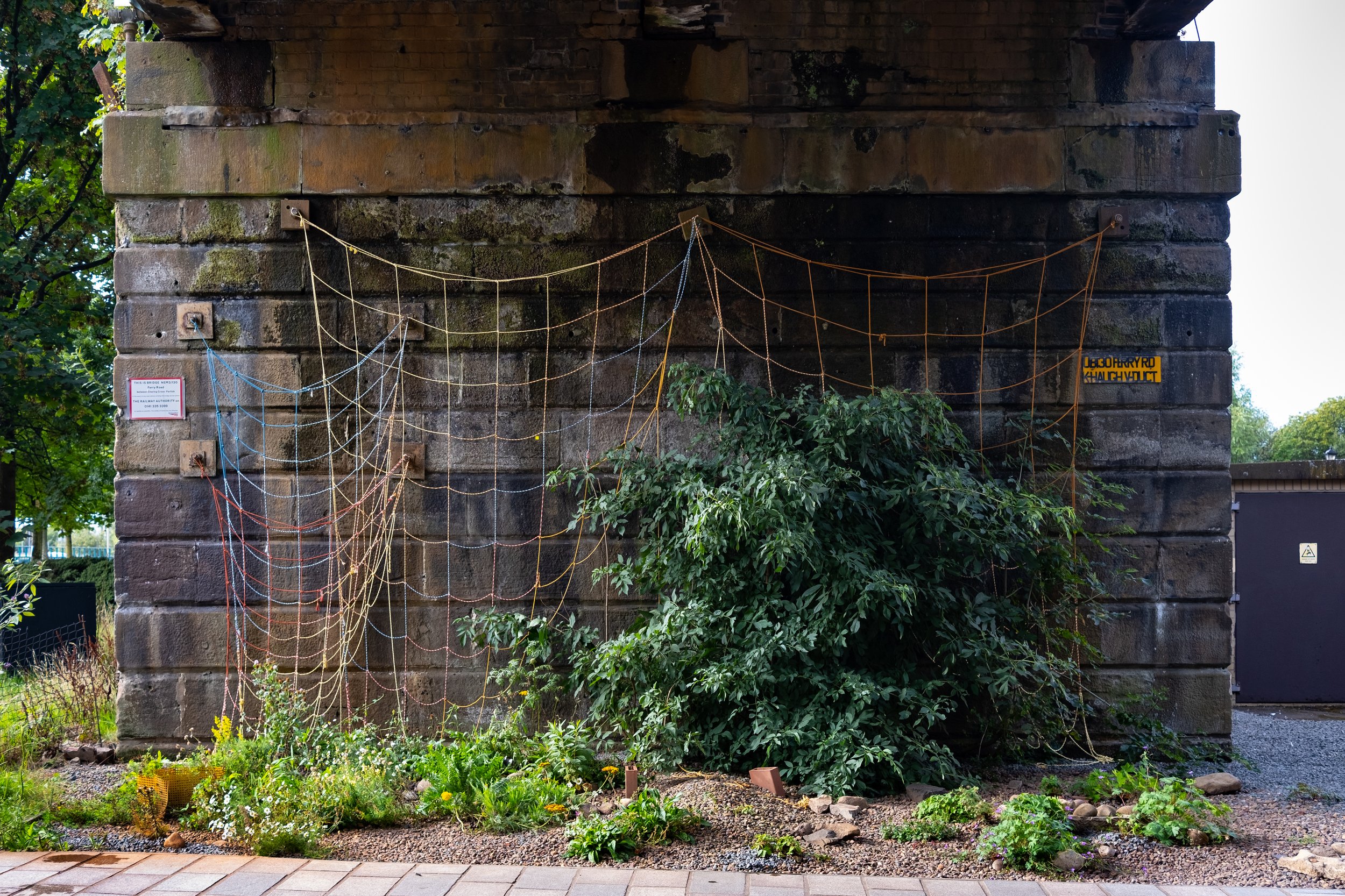A brownfield garden and art project space in Yorkhill, Glasgow.
The Verge
Long term permission has been given for this site to be improved for the community and environment. It had been derelict for over 25 years with local residents watching this space used as a dumping ground. Brownfield sites often create a rich foundation for nature and their importance in our post industrial landscape is now being recognised. The site has been developed into garden based on brownfield ecology and also as a site for contemporary art projects.
This project has been supported by the landowner and Creative Scotland.
‘Dark Forms’
Jim Colquhoun
Jim Colquhoun's project is intended to highlight and celebrate the humble Moth. Often undervalued and overlooked they inhabit an important ecological niche and 2024 saw an alarming drop in the number of Moths (and many other insects). With this project we want to make people aware of this issue, present ideas on how they could create and support ecosystems which encourage moths (and other invertebrates) to thrive within the city.
As well as its place in the natural world the Moth features strongly in human culture and society. In ancient Egyptian mythology they represent the journey towards death and similarly in Native American cultures are seen as messengers from the spirit world. In modern folklore and popular culture ‘The Mothman’ is a mysterious figure who appears at times of great instability and change.
THE GIRL WITH THE PAINTED ON EYES
They live amongst us, a bit grey, shabby-looking and kind of fuzzy round the edges, dusty you might say; and we occasionally glimpse them when they are forced out of their diurnal comfort zones, but only for a second as their natural camouflage allows them to almost instantly slide from our gaze. Our sensory apparatus is too gross, chained as it is to linearity and rote perception, which they of course use to their advantage. At school they were the ones no one can recall, that even the bullies forgot to remember to harass. They merge seamlessly with our dull architecture and prefer locations where local particularities have been washed away by money. Mothkind you might call them. For all that they abhor and avoid us we do have our uses, specifically for sexual reproduction. Yes they want to mate with us. This is when their natural urge to hide morphs into something else. You probably barely remember that drunken one night stand with the girl or boy whose eyes in retrospect seemed somehow, impossibly, painted on. A fuzzy memory of papery flesh rustling in the half light, murmuring caresses and a strange feeling of immobility that you put down to drunkenness but that was, perhaps, something else. Their outré reproductive cycle requires both eggs and sperm and so they briefly embody our preferred archetypes of beauty and desire. Dusky, ambiguously asexual houris, they glance hypnotically across a crowded room and you are gone. Is there a price to pay for their attentions? I’m afraid there is, you see they not only extract but occasionally implant and in time, after a few cycles of the moon, you may find yourself reluctant to meet the full gaze of the sun and you begin keeping to the shady side of the street. Afternoons spent in the cinema seem suddenly attractive, as do dark bars, tunnels, being deep in the woods, all of these you seek out as your friends inexplicably fall away and one day, around dusk, you see their painted on eyes gazing out from that disused underpass and you find that you are replying in kind to their sibilant rustling call and that you too are now mothkind.
Jim Colquhoun
We planted moth supporting plants which included; Miss Willmott’s Ghost, Hyssop, Wild Clematis, White Campion, Apple Mint, Wild Foxglove, Golden Rod and Common Jasmine, and installed a gabion shelter/nest filled with leaves and sticks.
On the evening of the 26th of July we held our first mothing event as part of Moth Week.
‘Imagine that clothes moths were even slightly larger, dwellings across the world would be ringing with screams as the not so little dusty squishy creatures settled softly on your cheek in the night time.
Our relationship with the moth is complex, their mysterious nightly sojourns are the stuff of nightmares (although only one is a true vampire) and they are both feared and shunned. Yet they are harmless pollinators who form an important part of our ecosystems, going about their not entirely nocturnal business for going on about 350 million years. They feature in mythologies across the world, often as intermediaries between us and the world of spirit.’
Eclipse* event on the 30th of August.
Humans and the night-flying lepidoptera mixed for a mix and mingle by way of a special sugary concoction and a human-friendly ‘mothtail’ known as Miss Willmott’s Ghost, to help oil the wheels of interspecies communication. Jim produced a special mothzine for the event which was available to the partygoers.
*a group of moths is known as an eclipse
Jim Colquhoun is interested in performance, film, site-specificity, sound, writing as art, liminal edgeland spaces, speculative fiction and philosophical dead ends. Over the past few years he has produced site-specific performances, short films and gallery-based collaborations featuring a combination of film, sound, sculpture, text and performance. His work interrogates the ways in which different artistic practices can infect each other – sculpture bleeds into performance and vice versa, text takes on the lineaments of drawing, place infects everything.
When he approaches a new project he usually tries to find a particularly resonant space to ‘collaborate’ with; in the past these have included a 17th century castle, a piece of lost woodland, an abandoned shop unit and a detritus-filled beach. As well as this he will often choose a particular text that serves to help kickstart the process. In the past these have included early science fiction novel ‘A Voyage to Arcturus’ by David Lindsay, 17 century philosophical treatise ‘An Anatomy of Melancholy’ By Robert Burton and a performance-related text piece by artist Chris Burden amongst others. He is interested in the collaborative process and has worked with fellow artists Steve Hollingsworth, Jamie McNeill and Ceylan Hay.
‘Points of Attachment’
Jo Ball
Jo Ball will be showing at The Verge from the 27th of August till the 15th of October.
We will be having an opening on Saturday the 27th, 2:30pm. Please come along.
Jo Ball is an artist & gardener based in Bristol, UK.
Through drawing, installation and participatory projects she makes work that considers aspects of place, nature and how humans connect to their environment. A deep curiosity for making and materials is at the root of her approach.
Since studying Tapestry at Edinburgh College of Art followed by an MFA Studio Arts in Montreal, she has been the recipient of several residencies and awards. Her work has also been included in numerous exhibitions and is held in private and public collections within Canada and Europe.
Jo’s site visit in May.
Connectedness
Purposefully casting her net wide on a recce to the Glasgow site, Jo Ball Instagram dm’s me with an invitation to meet for coffee and conversation. Strangers related by practice and community converge with few clues to aid recognition, but as promised chat ensues and similitude comes to light, the aggregate of unseen threads & imaginative projection – ‘visible, invisible, like those threads, now seen, now not, that unite trembling grass blades in autumn before the sun rise’ (Woolf, V. Between the Acts). Friends, children, showing, & growing, recalled in imprecise ways – and with perplexing familiarity close to déjà-vu, that reorders & discredits faith in memory.
Jo’s profile describes her as Artist and Gardener. Currently based in Bristol, Jo graduated from Tapestry at Edinburgh College of Art 20 years ago, only recently returning to Scotland to visit. Her focus on her own art practice (making the distinction from her work in the garden for the moment) surfaced, or more accurately was reactivated at about the time her son Ben was born, at a juncture that would almost certainly have forced a realignment in self-perception. Far from limiting her art making, the practice of parenting it seems created a site for empowerment.
Verge: An extreme limit beyond which something specified will happen.
The Verge is a brownfield garden and project space established by artist Mary Redmond (Glasgow), giving a once derelict site new purpose to benefit nature and the community through ruderal planting and sculptural intervention. In the collected works, Remember Nature, Brian Eno asks us ‘For one week, think about everything you do in terms of whether it strengthens or erodes community’. Here under a rail bridge in Yorkhill is a narrow moment between park and expressway, the confluence of the river Kelvin & Clyde, offering an invitation to proximity and connectedness.
Points of attachment is a work made specifically for The Verge. It is composed of four large nets, constructed from naturally dyed cotton rope, some in plain colours & some striped. ‘I discovered that by unravelling thicker rope, three twisted stands produced dyed spirals around the individual strands,’ Jo explains. Made at home, nets reach horizontally across shelving and kitchen table; when on the site they are suspended vertically, utilising pre-existing attachment points. The title of the work refers to attachment theory (as observed in the work of British Psychologists John Bowlby and Mary Ainsworth) & in a general sense to lasting connectedness between human beings.
I imagine the process of making each net by hand to be reassuringly regular for Jo, firming up thought in each repeat. Jo’s body shapes the work as she winds the dyed rope, an end on one hand, around the v of that thumb and forefinger, down to the elbow and back up the make the loops. The drawing out of rope becomes net, line becomes enclosure, via the process of knotting - controlling, registering & bonding; a pause before the line overtakes the lump and continues, is sustained and hopeful. As in the work of Eve Hesse & Robert Morris before her, Jo’s work happens in the act of formation. It exists on site in one form but is mutable according to the effects of the gravity & stress on her simple materials. Antidote to a less intuitive, more easily definable, hierarchical notion, by which a process leads logically to a solution.
For Jo, the environment is clearly collaborator, second cousin to other gardens she has laboured in, each square net a viewfinder of time (her routine) and space (her ecology). Against the brick on site, I imagine net units even in their provisionality, providing tempting footholds for climbing children or enthusiastic tendrils hungry for light. As Artist and Gardener, Jo has a heightened sensitivity and deference to the temporality of site and material, where many an artist at some point has a desire for duration, if not legacy. Kathryn, my mother-in-law is a gardener. I ask her what the practice teaches you – ‘how to observe, compose, accept the cycle of life and death, ultimately to grow’ she answers, ‘the process is always new, humbling; composting is decay and is also life giving’. Participating in an active site, the Artist-gardener nudges an ongoing process, rather than imposing matter and form as in Aristotle’s hylomorphic model.
Looking back on Jo’s early work made in 2013, arrangements of ephemeral natural materials (string, wool, wood, dried flowers, berries) are posed figuratively, wired together loosely with impudent lightness, existing only for the moment of the exhibition in her London flat, bringing nature inside. The 2013 exhibition included an early net in this case made from barely visible filament florist wire. Jo tells me she has made nets for years and sees them as a metaphor for the way memory acts. What gets lodged permanently and why some things slip away.
While in Glasgow, Jo remembers her grandfather figure, Gordon, with great fondness. A member of the merchant navy he would have docked in nearby Yorkhill quay. For Jo, there’s some discomfort in describing the work as representational, but in setting the gauge for each square by the length of adult and child forearms, the 4 nets, at a moment along the line, became a family. Forming a personal and shifting topography, the net is cellular, potentially infinite; far from simple outline it is complex container of imprecise ecosystems, a quilt pieced together by our antecedents.
I want to share this emptiness with you
Not fill the silence with false notes
Or put tracks through the void
I want to share this wilderness of failure
The others have built you a highway fast lane in both directions
I offer you a journey without direction
Uncertainty and no sweet conclusion
Here Michael Gough narrates as kaleidoscopic images materialise in Derek Jarman’s The Garden (1990). At Jarman’s Prospect Cottage this garden is, like The Verge, an unconventional plot. It runs all the way to the horizon in every direction without fences or walls. The nuclear power station at the end provides an atmospheric and unsettling low hum. Its glow by night illuminates the landscape & is a feature of it. Unlike in the gallery, light levels outside transform the colours of flowers, surface textures of leaves, transform material substance, affecting design to convey drama, motion and evoke emotion.
In the final scenes orange flickering before end credits roll like premonitions. Flash back to devastating forest fires ripping through acres of California, Brazil, Australia, & France, as temperatures rise, with unprecedented numbers of blazes breaking out in the UK this year. The notion of garden is upended. It becomes a stage where everything is both significant and inconsequential. At this moment in our history, at the brink of ecological ruin, I have an idea of this place - The Verge - aware of its own temporality, collaborative in its animacy, hopeful in its creativity, obstinately inconclusive.
Sara Barker
July 2022
Jo Ball is an Artist and Gardener based in Bristol. Her BA in Tapestry at Edinburgh College of Art was followed by an MFA at Studio Arts, Montreal. She is currently showing in the exhibition ‘Nature our environment’, at Kingshill House from 16th July – 24th September 2022. Later in 2022 she will begin a commission at Mangotsfield Folly, on the Bristol-Bath cycle path - planting hundreds of spring bulbs to be sung to when they flower the following spring. Recent projects include: Summer Residency at the Garage (2021), Arts Council DYCP (2021), Patches of Blue Sky at OSR Projects (2017) and Transition residency at Newlyn Art Gallery (2017)
Text written by Sara Barker
Images by Patrick Jameson
Points of Attachment, Jo Ball, 2022
Cotton rope dyed with madder, corepsis, buddleia and indigo





